Cleaning and shaping of the root canal system is one of the most important procedure in endodontic treatment [1]. Various root canal instruments and techniques have been proposed for cleaning and shaping the root canal system. However the creation of a continuously tapering conical form, thorough debridement, maintenance of the original canal shape and position of the root canal and apical foramen are still difficult, especially in curved canals [2]. In addition procedural accidents such as ledges, zips, perforations and instrument fracture may occur while instrumenting the curved canals [3].
Endodontic instrumentation is undergoing a phase of transition. Nickel titanium instruments were found to be quite efficient in root canal preparation particularly in curved canals. These instruments have gained popularity because of its elastic flexibility and resistance to torsional fracture [4]. Thus these instruments offer possibilities of improving the speed and efficacy of root canal instrumentation [5].
The clinical concern is that they have been reported to undergo fatigue failure which occurs unexpectedly without any sign of previous deformation and therefore visual inspection would not seem to be the ideal way of evaluating nickel titanium instruments in order to prevent fracture [3, 6–8].
The aim of the present study is to evaluate and compare the cyclic rotations needed to fracture three different rotary nickel titanium endodontic instruments namely Profile, K3 Endo, RaCe in simulated curved canals having 2 different radii of curvature, i.e., 5 mm & 10 mm with a constant angle of curvature of 45°.
The above analysis may provide insights on the average working time and thereby minimize risk of instrument breakage with in the canals during clinical application.
Materials and Methods
Sixty rotary nickel titanium instruments were used for analysis in this study. The instruments were divided into three groups based on the different cross sections [Table/Fig-1]. Three groups were further divided into two sub groups based on radius of curvatures. two different radii 5 mm and 10 mm with a constant degree of curvature of 45 degrees were taken in the study. Ten files were tested in each sub-group. The taper and the size of the instrument was standardized in all the groups i.e 25 size,0.04 taper and 21mm files were used in the study. Files were rotated at a speed of 300 rpm in a custom made experimental set up which simulated curved canals.
Instruments used in the study
| Group | Instruments |
|---|
| Group A | Profile (Dentsply Maillefer SA, Ballaigues, Switzerland) |
| Group B | K3Endo (SybronEndo, CA, USA) |
| Group C | RaCe (FKG Dentaire Switzerland) |
A custom made experimental set [Table/Fig-2] up was used for evaluating cyclic fatigue of the Ni-Ti instruments. It comprises of dental hand piece attached to the descending cross head of Universal testing machine (Lloyds, Lloyds instruments, UK) and a shaping block for endodontic files. The shaping block was fixed and consisted of concave tempered steel radius and a convex tempered steel cylinder that guaranteed curve of the instruments during rotation. This concave radius incorporated a notch for guiding the instruments in the canal which had two radii of curvature 5 mm & 10 mm [Table/Fig-3,4].
Experimental set up showing (1) dental handpiece attached to the universal testing machine (2) stainless steel shaping block.
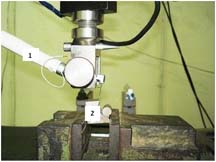
Shows the shaping block (1) concave radius (2) convex cylinder
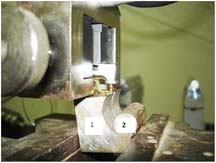
Notch for guiding the instruments
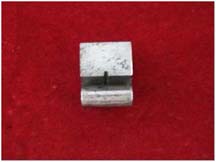
These instruments were mounted on an electric motor (Endomate DT, nsk Japan) operated with a 16:1 reduction handpiece which was attached to the descending cross head of Universal testing machine and were rotated in the notch of the a shaping block until fracture occurred and the fracture time was recorded for each group. Twenty instruments in each group were tested within both types of simulated canals. The time to fracture was multiplied by the number of rotations per minute to obtain the number of cycles to failure (NCF) for each instrument. Mean values were then calculated.
Fracture surface’s of all the files were analyzed with a scanning electron microscopy (SEM) to determine the mode of fracture. SEM was taken at 200 X and 800 X magnification to determine the characteristics of the fracture process for the test conditions.
Statistical analysis was done using students t-test to find out the significant difference between the subgroups and one way ANOVA and Tukeys – HSD was done to determine whether any significant difference exists between the individual groups. P value was set at < 0.05.
Results
The time to fracture was multiplied by the number of rotations per minute to obtain the number of cycles to failure for each instrument.
Statistical analyses of the number of cycles to failure in all the groups are presented in [Table/Fig-5,6].
Comparison of mean values between subgroups for each study group
| Groups | Subgroup I | Subgroup II | p-value |
|---|
| Mean±S.D | Mean±S.D |
|---|
| A | 2248±515 | 1120±155 | <0.0001 |
| B | 1704±351 | 900±78 | <0.001 |
| C | 1191±316 | 635±149 | <0.001 |
Comparison of mean values between different study groups for each subgroup
| Subgroup | Groups | Mean±S.D | p-value | Significant Groups |
|---|
| I | A | 2248±515 | <0.0001 | A vs C |
| B | 1704±351 | A vs B |
| C | 1191±316 | B vs C |
| II | A | 1120±515 | <0.0001 | A vs C |
| B | 900±78 | B vs C |
| C | 635±149 | A vs B |
Graphical representation of the same are presented in [Table/Fig-7,8].
Comparison of mean values between subgroup for each study group
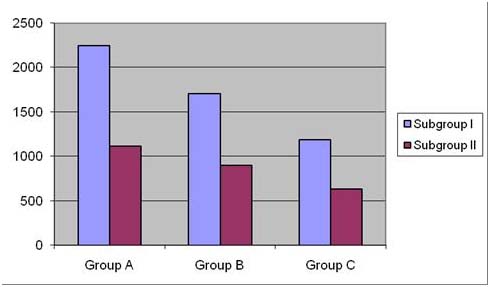
Comparison of the mean values between different study groups for each subgroup
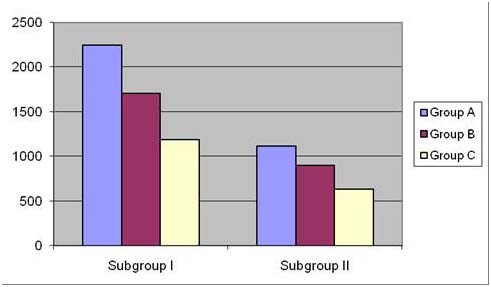
Group A (Profile) showed increased no. of cycles to failure i.e., low incidence of fracture at both the radii of curvatures when compared to the other two groups.
Group B (K3Endo) showed an increased no. of cycles to failure when compared to Group C but significantly less when compared to Group A.
Group C (RaCe) showed the least no. of cycles to failure, i.e., higher incidence of fracture when compared to the other two groups.
[Table/Fig-6] shows the mean values between the 3 groups (Profile, K3endo, RaCe) for each subgroup. The comparision between the three instrument groups showed statistically significant difference with respect to fracture time. In this comparision also Group A showed low incidence of fracture i.e., higher number of cycles before failure.
SEM analysis
In GroupA the fracture surface of the files tested were characterized by the presence of smooth area on their edge associated with nucleation and slow fatigue crack propagation and a large central area corresponding to the final ductile fracture which is seen at 200X magnification, amount of microvoids and dimples observed were very few in Group A when compared to Group B and C [Table/Fig-9a,b,], [Table/Fig-10a,b,] and [Table/Fig-11a,b,].
SEM images of Profile at 200X and 800X
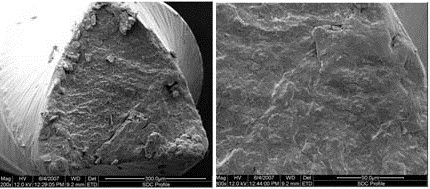
SEM images of K3Endo at 200X and 800X
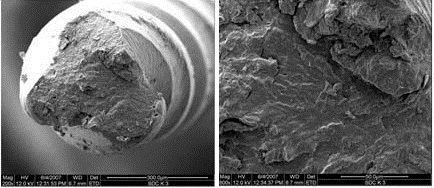
SEM images of RaCe at 200X and 800X
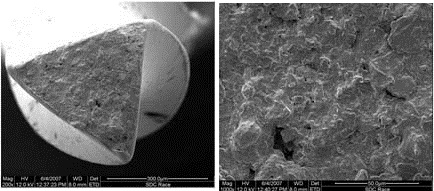
In Group B the microvoids and dimples were more than in Group A.
In Group C the amount of small cavities and dimples were more when compared to Group A and B.
Discussion
One important contributing factors for success of root canal therapy is thorough biomechanical preparation. This phase of treatment consists of cleaning and shaping of the canal and is a challenge particularly when shaping curved canals [9].
According to Goldberg et al enlargement of the apical third, may lead to curvature defects such as apical transportation, ledging [10] or zipping which might compromise the outcome of treatment.
The continuous search for improvement of rotary endodontic instruments lead to the introduction of nickel titanium alloys which opened a new perspective in endodontics because of their special features i.e. super – elasticity and shape memory [9]. Despite the many advantages of NiTi instrumentation, unexpected fracture sometimes may occur during clinical use. One of the most important being flexural fatigue in the fracture of NiTi instruments.
Cyclic fatigue is caused by repeated tensile and compression stress. As an instrument is held in a static position and continues to rotate, one half of the instrument shaft on the outside of the curve is in tension, while the other half of the instrument shaft on the inside of the curve is in compression. This repeated tension- compression cycle caused by curved canals, increases cyclic fatigue of the instrument over time and may be the most important factor in instrument separation [11].
In the present study instruments in Group A (Profile) showed the maximum fatigue resistance i.e., more number of cycles to failure at both the radii of curvature (i.e.) 5 mm and 10 mm when compared to the other groups which was in accordance with the study done by Yared et al., Di Fiore et al., [12–15].
The reduced instrument fracture could be explained by the fact that profile instruments have a central parallel core inside that may account for the enhanced flexibility compared to K3 and RaCe.
Group B showed a greater no. of cycles to failure than Group C but showed significantly less fatigue resistance than Group A. K3endo system showed distortion as a bending of the file along its long axis
From the results of this study it can be hypothesized that variable core diameter unequal land width, flute width could have contributed to the reduced fatigue resistance of the instruments in Group B.
The fractured instruments surface was subjected to SEM analysis. It has been accepted that SEM studies seem to be the most adequate method for accurate evaluation of fractured sites [9].This method has been used in other studies done by Zuolo & Walton, Rapisarda et al., Svec & Powers [16–18] It has been claimed that SEM images may help in understanding the fatigue behavior of the nickel titanium alloys [19].
Conclusion
As cyclic fatigue has been a concern in engine driven nickel titanium instruments. This study presents a realistic assessment of the incidence of fracture and supports the careful and prudent use of these instruments in the root canal preparation, thereby giving an idea to the clinician the adequate time, adequate values for fracture resistance so that the instruments can be used more cautiously in severely curved canals.
This study leads to future directions of including the cyclic fatigue test specification for all rotary nickel titanium endodontic instruments to minimize the risk of fracture.